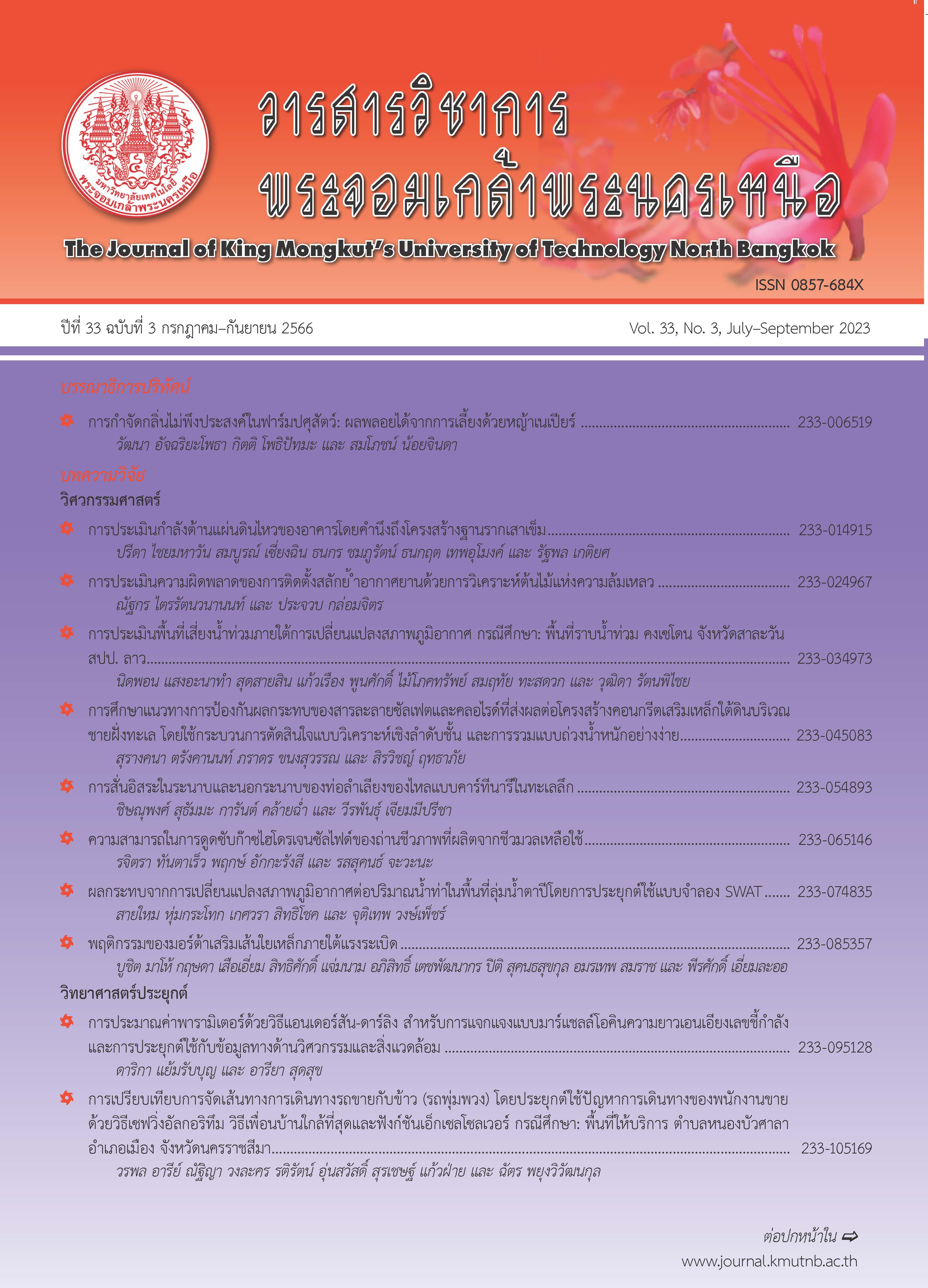Hydrogen Sulfide Adsorption Capability of Biochar Produced from Residual Biomass
Main Article Content
Abstract
This study aimed to investigate the adsorption capacity of hydrogen sulfide (H2S) by biochar prepared from agricultural waste. The biochar samples include carbonized corn cob (C), carbonized corn cob under CO2 rich atmospheres (CA), carbonized coconut shell (CO), carbonized coconut shell under CO2 rich atmospheres (COA), carbonized woodchips (B) and carbonized woodchips under CO2 rich atmospheres (BA). All samples were carbonized at the controlled temperature (500 ± 10 °C). H2S adsorption capability were evaluated in a continuous manner using actual biogas produced from ethanol waste with controlled H2S loading rates of 4,300 ± 20 g/m3-h. The experimental measurement of the H2S adsorption capacity of C, CO, and B were 2.33 ± 0.09, 3.66 ± 0.63, and 5.56 ± 0.77 g H2S/g Adsorbent material, respectively. The adsorption capacity of CA, COA, and BA were 1.58 ± 0.90, 1.84 ± 0.75, and 1.26 ± 0.20 g H2S/g Adsorbent material. It is thus clear that carbonized woodchip (B) has significantly higher adsorption capacity than carbonized corn cob (C) and coconut shell (CO). Concisely, carbonization under CO2 rich atmosphere cannot enhance adsorption capacity; instead it induces negative effects in most cases.
Article Details

This work is licensed under a Creative Commons Attribution-NonCommercial-NoDerivatives 4.0 International License.
The articles published are the opinion of the author only. The author is responsible for any legal consequences. That may arise from that article.
References
O. W. Awe, Y. Zhao, A. Nzihou, D. P. Minh, and N. Lyczko, “A review of biogas utilisation, purification and upgrading technologies,” UCD Dooge Centre for Water Resources Research, School of Civil Engineering, University College Dublin, Newstead, Belfield, Dublin 4, Ireland, January 2017.
M.A.M.Khraisheh, M.A.Al-Ghouti, S.J.Allen, and M.N.Ahmad, “Effect of OH and silanol groups in the removal of dyes from aqueous solution using diatomite,” Water Research, vol. 39, no. 5, pp. 922–932, 1979.
Office of Agricultural Economics. (2018, March). Agricultural Statistics of Thailand 2018. [Online] (in Thai).Available: http://www.oae. go.th/assets/portals/1/fileups/prcaidata/files/ maize%20province%2061(1).pdf
G. Shang, G. Shen, L. Liu, Q. Chen, and Z. Xu, “Kinetics and mechanisms of hydrogen sulfide adsorption by biochars,” Bioresource Technology, vol. 133, pp. 495–499 , 2013.
S. Sumathi, M. Zhang, A. U. Rajapaksha, S. R. Lee, N. M. Nor, A. R. Mohamed, M. Al-Wabel, S. S. Lee, and Y. S. Ok, “Biochars as Potential Adsorbers of CH4, CO2 and H2S,” Sustainability, vol. 9, no. 1, pp. 121, 2017.
S. Suwannachot, “Adsorption capacity for organic and inorganic gas of the impregnated coconut base activated carbon,” Ph.D. dissertation, Department of Environmental Management Science and Technology, Faculty of Science and Technology, Thammasat University, 2016 (in Thai).
V. Tanusilp and S. Laowansiri, “Hydrogen sulfide Removal from Biogas by Activated Carbon and Iron,” presented at the 9th National Kasetsart University Kamphangsaen Conference, Nakhonpathom, Thailand, 2012 (in Thai).
M. Tangsathitkulchai and C. Tangsathitkulchai, “Preparation and Adsorption of Wood-Based Activated carbon,” Institute of Science, Suranaree University of Technology, Nakhon Ratchasima, Rep. SUT1-102-50-12-38, 2007 (in Thai).
A. Wongkaew, “A study of preparation conditions of bimetallic oxides (Copper and Ferric) affecting to their physical properties and catalytic activity to CO oxidation reaction,” presented at Burapha University International Conference, Chonburi, Thailand, July 3–4, 2014 (in Thai).
P. Rungrojchaipon, “Porous Materials?,” Journal of Science Ladkrabang, vol. 20, no. 1, pp. 63, 2011 (in Thai).
M. Gourani, A. Sadighzadeh, and F. Mizani, “Effect of impregnating materials in activated carbon on Iodine -131 removal efficiency,” Radiation Protection and Environment, vol. 37, no. 3, pp. 179–183, 2014.
N.-S. Md-Desa, Z. A. Ghani, S. Abdul-Talib, and C.-C. Tay, “Optimization of activated carbon preparation from spent mushroom farming Waste (SMFW) via box-behnken design of response surface methodology,” Malaysian Journal of Analytical Sciences, vol.49, no.1, pp. 461–468, 2016.

